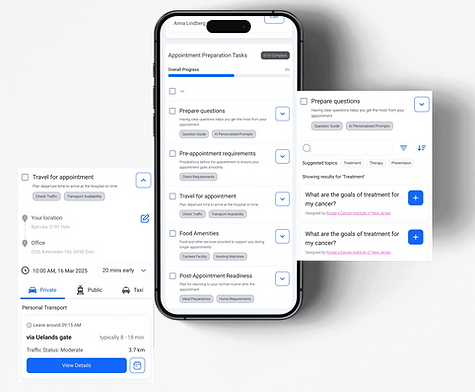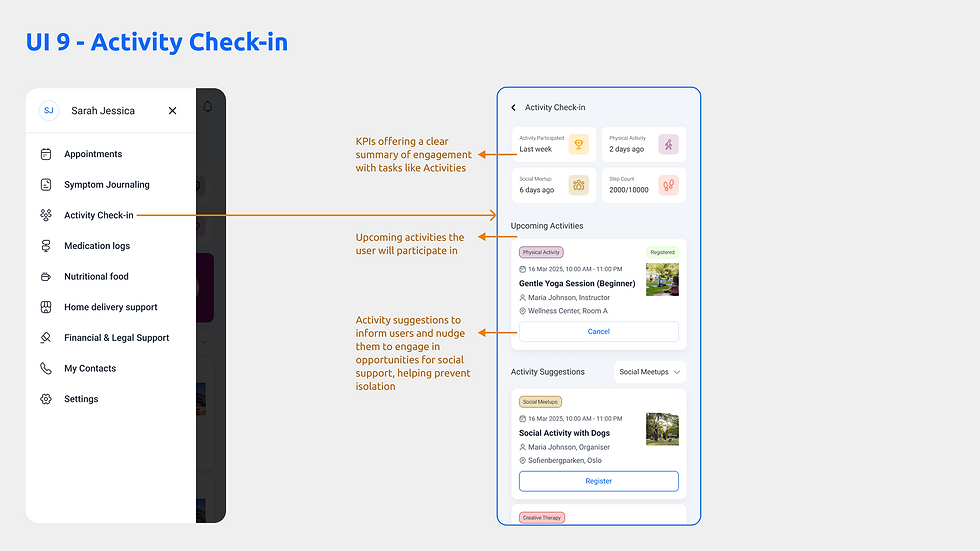Care Companion: Digital Support for Single Cancer Patients
Product Design, Service Design, Design Research
Project Scope
-
Explored and designed a digital support solution for single cancer patients without informal caregivers.
-
Conducted comprehensive patient journey mapping and needs analysis to identify challenges and support gaps.
-
Analysed stakeholder roles and assessed existing solutions within the care ecosystem.
-
Designed an integrated digital support platform for single cancer patients, providing adaptive, independent support with tools for appointment management, consultation preparation, medication reminders, symptom tracking, resource access, and supportive resources like a centralised community network.
-
Explored use cases for integrating AI and metadata to enhance patient support.

-
Designed key UI features, including appointment management, symptom journaling with analytics, medication tracking, and activity check-ins.
Centralised Community Network
Symptom Log
Support prepare for appointment
Appointment Scheduling
Medication Reminders
Patient-Focused Appointment Preparation Tasks

Transport Availability
Prepare Questions for consultation
Highlights
-
Designed an end-to-end appointment journey covering scheduling, consultation preparation, and reintegration into daily routine, providing comprehensive support to empower patient independence in managing their care.
-
Designed a detailed symptom journaling flow with manual and AI voice input, with visual progress insights, to help users recall experiences and articulate their needs.
-
Leveraged AI to simplify symptom journaling and generate health summaries, to help users recognise symptom patterns and recall health changes over time.
-
Leveraged real-time metadata on appointment status, traffic, and food quality/accessibility at appointment sites to improve patient experience during longer visits
Key Role and Responsibilities
-
As part of a university research project in Oslo, conducted in-depth user research on challenges and support gaps faced by single cancer patients to help them navigate social support, access practical resources, and maintain social connections to prevent isolation.
-
Investigated healthcare service limitations and caregiver shortages impacting patient care.
-
Applied service design methodologies to frame project scope and define user needs.
-
Utilized design thinking to ideate and develop a digital support platform for patient empowerment.
-
Designed end-to-end user journeys focused on lifestyle and non-medical task management.
-
Integrated AI use cases to simplify symptom tracking and routine healthcare tasks.
-
Developed detailed UI flows and scenarios using Figma to prototype user interactions.
-
Advocate for patient independence by creating a reliable, flexible support system that fills informal caregiver gaps and streamlines access to healthcare resources.
-
Project in exploratory phase with planned user testing for experiential validation.
-
Demonstrated technical proficiency in product design, with a focus on healthcare technology and healthcare UX.
Contents
Project summary
This project explored the design of a digital solution to support single cancer patients navigating their journey without informal caregivers.
Research included mapping patient journeys, identifying challenges and needs, analysing stakeholder roles, and reviewing existing solutions.
Key challenges uncovered were varied patient needs and access barriers, overloaded kreftkoordinators managing high caseloads, limited understanding of treatment information without relatives, and the isolation patients may face without a supportive network.
Design Outcome is a healthcare app that provides practical resources, structured consultation preparation, and tools to express daily challenges. It complements, rather than replaces, professional and caregiver roles by providing adaptive support that integrates into patients’ lives.

The overarching goal is to protect patients’ independence while creating a reliable, flexible support system that fills the gap left by absent informal caregivers.
Background & Role of Informal Caregivers
Cancer care is a complex, multi-stage process that relies on coordination between hospital services and municipal community care in Norway, ensuring patients receive continuous support during treatment and in daily life at home.
Cancer coordinators play a crucial role in supporting patients - Forløpskoordinator at the clinical level and Kreftskoordinator at the municipal level
In addition, informal caregivers such as family members or relatives are essential, providing practical support, emotional reassurance, and assistance in managing the challenges of treatment and daily life.
Together, they form a vital part of the overall care network.
The healthcare system is designed to support all cancer patients, whether they live alone or with family. However, single patients without informal caregivers often face greater isolation and must manage the challenges of their cancer journey and responsibilities on their own.


This image illustrates informal caregivers as part of a cancer patient’s close support network, highlighting the impact created by their absence.
This map illustrates cancer-related services in Norway, where cancer coordinators, Forløpskoordinator (clinical level) and Kreftskoordinator (municipal level), serve as the main network connecting and coordinating services for patients.
"This person is the main emotional support for our patients daily. So he or she needs to be invited to come to the clinical appointments... This person is our best link to the patient at home and our best assistant."
Souce: Luzia Travado, Cinical health psychologist at Champalimaud Foundation in Lisbon; Article: Informal carers play a key role in cancer care, CancerWorld.net
Research Question
How do single cancer patients access practical and emotional support throughout their cancer journey, particularly after completing cancer treatment?
Research Summary
-
Desktop Research: Cancer care for patients in Norway, including understanding the stakeholders and their role
-
Mapping cancer care journey and stakeholder relationships
-
Designed user personas to identify target users
-
Mapping single cancer patients challenges and needs
Key Challenges
-
Varied needs and access challenges: Each cancer journey is unique, making standardised coordination difficult, and some patients face barriers that limit access to available services.
-
Staff shortages and high caseloads: Each kreftkoordinator manages care for multiple patients while coordinating with several partners, resulting in heavy responsibilities and numerous tasks to juggle.
-
Lack of close relatives: Without family support, patients may struggle to understand and remember information about their diagnosis and treatment
-
Isolation: The cancer journey can feel isolating without a supportive network such as an informal caregiver

This stakeholder map highlights the collaboration network of the Kreftkoordinator in supporting a cancer patient’s journey.
It also emphasizes that each coordinator manages several patients simultaneously, illustrating the complexity and intensity of collaboration required to provide every patient with personalized care.
User Persona
See the full report at this link: https://docs.google.com/document/d/1VIdZIa8TyOgBurOxg1Rl5CZxiDE8DohwJWrnG9NzQ6E/edit?usp=sharing

Based on research, I identified three distinct user personas. In the initial phase, the focus will be on Personas 1 and 2, who are able to navigate their cancer journey largely on their own with minimal support.
Persona 3: The intersection of age, immigrant identity, and cancer faces additional barriers that may require direct human involvement. These challenges cannot be fully addressed within the scope of the current phase.
If this phase is successfully implemented and the goals for Personas 1 and 2 are achieved, resources can later be reorganised and distributed more evenly across all single cancer patients. This will allow support efforts to be tailored based on the level of caregiver or human assistance each individual requires.
Ideation
The following is a PDF file. Please use the ‘>’ button at the bottom or 'scroll horizontal' to navigate through the pages.
Mapped the patient journey post-treatment into smaller phases to identify recovery needs and accessible support, focusing on the practical help and emotional reassurance single cancer patients often lack.
Design Focus

Integrated digital support to streamline lifestyle and non-medical task management

Support patients in articulating needs and preparing for consultation discussions

Raise awareness and simplify resource access

Centralised community network to connect and reduce isolation, including support beyond traditional social work or volunteering

Monitor symptoms over time to help recall important details

Clear workflow to coordinate appointments and visits while preserving daily routine balance
.png)
Access to nutritional food and resources to support patients when they cannot cook, plus tools to help prepare nutritious meals independently
Design Outcome
Design an integrated digital support platform aimed at streamlining lifestyle and non-medical task management for single cancer patients. The platform will raise awareness, simplify resource access, and help patients manage their daily health-related activities.

Image 1 - Home Screen UI: Provides users with essential information, including KPIs for key events, daily appointments, medication reminders, and upcoming tasks. Features include a navigation menu, notifications, and clear prompts to keep patients informed and engaged with their care.

Image 2 - Navigation Menu UI: Provides users with clear, concise access to key features, including Appointments, Appointment Preparation Tasks, Symptom Journaling with AI support, Activity Check-in with engagement KPIs, Medication Reminders, and Quick Contacts for tailored support.

Image 3 - Appointment & Details UI: Displays all appointments with a calendar for easy scheduling, shows appointment status (on time or delayed), provides quick contacts, and offers practical tasks to guide patients through each step of the appointment process.

Image 4 - UI - Appointment Preparation tasks from appointment details: Guides users through key steps such as preparing questions for consultations, planning travel, informing about hospital food amenities, and providing post-appointment estimates to help organise their day.

Image 5 - UI - Symptom Journaling: Enables users to log symptoms manually or by voice, view and track symptom progression over time with analytics, and easily search, sort, and filter journal entries categorised by symptom labels.

Image 6 - UI - Symptom Journaling Flow: Users can log symptoms manually or via AI-supported voice input, with speech-to-text transcription. AI organises entries into editable symptom cards, assigns intensity levels. Symptom journaling also allows users to track previous symptom logs from the same day.

Image 7 - UI - Symptom Analytics: Presents KPIs with a concise symptom overview and AI-generated insights. Data visualisations show symptom overview, intensity and frequency. Selecting a symptom expands the card to reveal detailed insights, including report frequency, average intensity, key user notes, and progression over time.

Image 8 - UI - Medication Logs: Provides KPIs to monitor medication doses, enables quick logging with two simple buttons, and displays a history of medication logs for easy tracking.

Image 9 - UI - Activity Check-in: Displays KPIs summarising user engagement with activities, shows upcoming activities, and provides personalised suggestions to encourage social interaction, helping prevent isolation.

Image 9 - Privacy & Metadata: Ensures patient data sharing complies with European Health Data Space (EHDS) regulations, safeguarding privacy and cybersecurity. Uses metadata standards for transparency and interoperable health data management, supports real-time appointment and transport updates, and anonymises hospital food and vending machine usage data for secure public insights.
Project Update
The project is in explorative stage and requires user testing to validate design and user experience.


